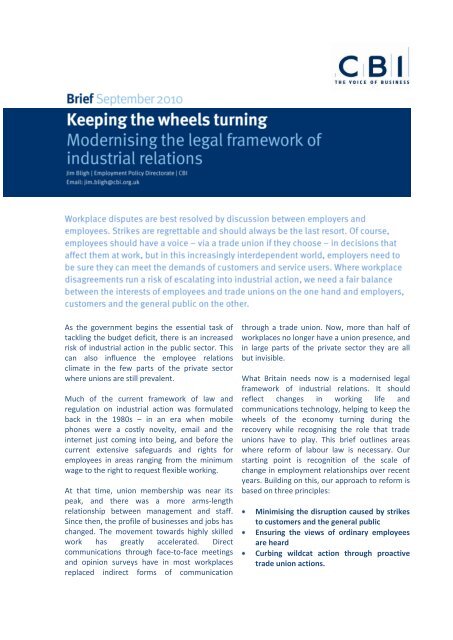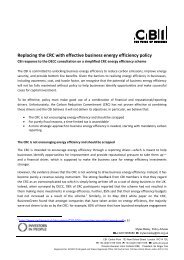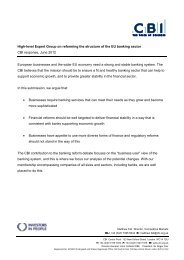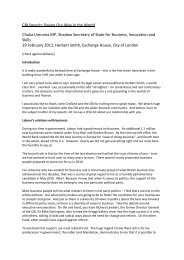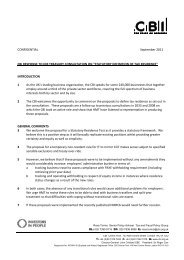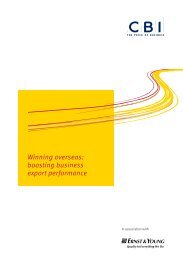Read the full policy brief (pdf) - CBI
Read the full policy brief (pdf) - CBI
Read the full policy brief (pdf) - CBI
Create successful ePaper yourself
Turn your PDF publications into a flip-book with our unique Google optimized e-Paper software.
negotiation and allow disputes to develop intostrikes.The partnership approach demonstrated during<strong>the</strong> recession across <strong>the</strong> private sector shouldnot, however, make us complacent. The publicsector was until 2009 largely immune from payfreezes and o<strong>the</strong>r testing changes in response totougher conditions. The previous governmenttended to back away from difficult employeerelations issues, such as reform of public sectorpension schemes.The new government has started to change that,for example by implementing a two-year payfreeze across <strong>the</strong> public sector as part ofrecognising <strong>the</strong> extent of <strong>the</strong> budgetarychallenge. But many unions seem reluctant toface up to this reality. At <strong>the</strong> 2010 TUC Congress,union leaders called for nationwide actionagainst spending and headcount cuts, with someeven urging a campaign of civil disobedience inprotest at <strong>the</strong> government’s essential work oftackling <strong>the</strong> deficit. This is particularly concerningfor <strong>the</strong> most vulnerable members of society, whodepend on reliable public services. It alsothreatens <strong>the</strong> hard-won reputation of <strong>the</strong> UK as agreat place to invest and create jobs.‘The growing risk of industrialaction makes it all <strong>the</strong> moretimely to update <strong>the</strong> legalframework.’None<strong>the</strong>less, <strong>the</strong> growing risk of industrial actionmakes it all <strong>the</strong> more timely to update <strong>the</strong> legalframework. Moreover, recently <strong>the</strong>re have beena number of high profile strikes which havecaused significant disruption to <strong>the</strong> generalpublic and businesses. Some of <strong>the</strong>se disputeshave raised questions about both <strong>the</strong> conduct ofcollective bargaining in <strong>the</strong> workplace of 2010and <strong>the</strong> appropriateness of aspects of labour lawrelating to trade unions.The regulatory framework around industrialaction was largely shaped in <strong>the</strong> 1980s. Just aslife in <strong>the</strong> workplace doesn’t stand still, <strong>the</strong>framework of industrial relations law too needsto be modernised.The <strong>CBI</strong> has developed a package of proposedreforms. Building on <strong>the</strong> proposals we releasedin June, <strong>the</strong> ideas below are not exhaustive: <strong>the</strong>yare intended to be a constructive, reasonablepackage which would bring <strong>the</strong> law up to dateand ensure a fairer balance. They have beendeveloped in consultation with <strong>CBI</strong> members in<strong>the</strong> light of <strong>the</strong>ir experience of industrial actionand key legal judgements since <strong>the</strong> last revisionof industrial relations law under <strong>the</strong> previousgovernment.Industrial action is not inevitable: if public sectoremployers, employees and unions adopt <strong>the</strong>positive approach we have seen in most of <strong>the</strong>private sector in response to economicpressures, necessary change can be achievedconstructively through discussion andnegotiation. This means managers must addressissues in <strong>the</strong> workplace head on and make <strong>the</strong>case for change, ra<strong>the</strong>r than shy away from
The law should be changed so employers canhire agency workers to cover for striking staff.One method employers sometimes use tominimise disruption to customers and <strong>the</strong> publicis to recruit suitably skilled temporaryreplacement staff so <strong>the</strong>y can continue toprovide essential products or services during astrike period.Currently, it is lawful to do so as long as <strong>the</strong>temps concerned are hired directly by <strong>the</strong>business, but a company cannot recruit tempsvia an agency. The law is unclear about whe<strong>the</strong>rit is even legal to hire workers from ano<strong>the</strong>rcompany in <strong>the</strong> same group. There is alsoconfusion about whe<strong>the</strong>r an agency could supplytemps to a business affected by industrial actionthat would normally employ a large number of<strong>the</strong>m, perhaps to meet seasonal demand.Employees have <strong>the</strong> right to withdraw <strong>the</strong>irlabour, and as long as <strong>the</strong> correct procedures arefollowed it is perfectly legal to do so. Employershave a responsibility to <strong>the</strong>ir supply chains,customers and employees to keep <strong>the</strong>irbusinesses up and running during a period ofstrike action.For this reason <strong>the</strong>re is no logic behind thisrestriction. If firms can hire temps directly toprovide cover, <strong>the</strong>re is no reason why <strong>the</strong>yshould not do so via an agency. This is not amatter of threatening <strong>the</strong> jobs of strikers, butra<strong>the</strong>r of providing essential cover during <strong>the</strong>period of action.Strikes are always regrettable, and it is far betterto solve disputes by negotiation in <strong>the</strong>workplace, not in court or on <strong>the</strong> picket line.Some strikes are enormously disruptive topeople’s lives. Whe<strong>the</strong>r it is taking <strong>the</strong> childrento school, getting to work, going on holiday orcarrying out <strong>the</strong>ir jobs, those affected byindustrial action need sufficient time to makeplans.Businesses can suffer too – and not just <strong>the</strong>organisation where <strong>the</strong> strike is happening.Companies rely on countless o<strong>the</strong>r businesses athome and abroad in <strong>the</strong>ir increasingly complexsupply chains to deliver <strong>the</strong>ir services or productsto customers. They too need time to plan fordisruption.Moreover, once a ballot result has beenannounced and a strike called, unions andemployers should still have time to negotiate aresolution and avert <strong>the</strong> strike.For <strong>the</strong>se reasons we propose that <strong>the</strong> noticeperiod for industrial action should increase fromseven to 14 days after <strong>the</strong> ballot takes place.Unions have been known to ballot on one issue –such as proposed redundancies or a pay claim –
and call members out on strike but <strong>the</strong>n, during<strong>the</strong> period of <strong>the</strong> strike, change <strong>the</strong> reason for itand call a fur<strong>the</strong>r strike. Some recent disputeshave seen <strong>the</strong> rationale for action changeconsiderably while <strong>the</strong> ballot result is still ‘indate’. At present, <strong>the</strong> law is unclear as towhe<strong>the</strong>r matters arising during <strong>the</strong> course of <strong>the</strong>dispute are covered by <strong>the</strong> original ballot or not.The law should be clarified so strikes can onlygo ahead if <strong>the</strong>y are based on <strong>the</strong> ballot relatingto <strong>the</strong> original dispute, with consequentialissues subject to a fresh ballot.now offer a variety of o<strong>the</strong>r services and benefitsfor members. Indeed, two-fifths of recognitionballots have resulted in <strong>the</strong> union not beingrecognised v , and unions sometimes lose ballotsdespite membership of above 50%.People at work should always be empowered todecide for <strong>the</strong>mselves if <strong>the</strong>y want to berepresented by a union or take <strong>the</strong> opportunityto use o<strong>the</strong>r routes to communicate with <strong>the</strong>iremployer. The law should be amended soballots are always held to enable employees todemonstrate whe<strong>the</strong>r or not <strong>the</strong>y supportrecognition of a trade union to represent <strong>the</strong>m.Where unions are present in workplaces, itshould be because of <strong>the</strong> positive support ofemployees. At <strong>the</strong> moment, employers canei<strong>the</strong>r recognise a union voluntarily or – if avoluntary agreement cannot be reached – aunion can apply to <strong>the</strong> Central ArbitrationCommittee (CAC) for statutory recognition. If <strong>the</strong>CAC believes that union membership in <strong>the</strong>proposed bargaining unit is greater than 50%,automatic recognition can be awarded – withoutany formal vote by <strong>the</strong> employees concerned.This cannot be right. The right of individuals tojoin a union is one of <strong>the</strong> hallmarks of a freesociety. But people opt to join unions for lots ofdifferent reasons. For some, union membershipis no longer primarily about wanting to becovered by collective bargaining – many unionsIn a similar spirit, where collective industrialaction takes place, it should be <strong>the</strong> result of aclear, positive decision by <strong>the</strong> workforceconcerned. Too often we see strike ballots thatback action on small turnouts among <strong>the</strong>affected employees. Recent strikes in <strong>the</strong> publicsector and some of <strong>the</strong> strikes on <strong>the</strong> LondonUnderground have not had widespread supportamong <strong>the</strong> workforce and yet caused majordisruption for service users. Industrial actionshould never be <strong>the</strong> result of apathy amongmainstream union members.For this reason we believe <strong>the</strong> test for alegitimate strike should mirror <strong>the</strong> statutoryunion recognition rules, requiring 40% ofballoted members to support it as well as amajority of those voting.This means that in a case where 1000 people areballoted, at least 400 should vote in favour of <strong>the</strong>action for it to go ahead. If turnout is, say, 600,<strong>the</strong> strike could go ahead provided 400 vote insupport.
If 1000 people are balloted and turnout is only300, <strong>the</strong> strike could not ahead even if all voterssupport strike action. This is because <strong>the</strong>proportion of <strong>the</strong> balloted workforce would fallbelow <strong>the</strong> 40% threshold.This would help ensure <strong>the</strong> views of ordinaryunion members prevail, and that majordisruption cannot be triggered by a relativelysmall but active group.(TULRCA), including maintaining accuratemembership records. The law should providegreater clarity about <strong>the</strong> definition of a ‘unionmember’ in order to ensure only paid-upmembers are eligible to take part in a strikeballot.A number of recent strike threats have beenaverted because unions neglected to follow rulesabout balloting that are clearly set out in law. Forexample, in one high-profile dispute, unionsfailed to maintain accurate membership recordsand balloted former members and long-closedsites. vi This led to <strong>the</strong> strike being ruled out oforder by <strong>the</strong> courts. These cases causeunnecessary disruption and incur significantcosts for employers, unions and, ultimately, <strong>the</strong>irmembers.The government could provide a solution to thisproblem by defining union membership in law.At present, membership is defined only inindividual union rulebooks, where definitions arefrequently very loose, sometimes includingpeople who stopped paying <strong>the</strong>ir subscriptionslong ago. In <strong>the</strong> interests of fairness andsimplicity, a legal definition could set out thatmembers who have not paid <strong>the</strong>ir subscriptionfor, say, three months should be ineligible totake part in a ballot. The union should also be ina position to prove that everyone who takes partin a ballot is a member.Unions should make greater efforts to complywith <strong>the</strong> requirements of <strong>the</strong> Trade Unions andLabour Relations (Consolidation) Act 1992Trade unions should be required to keep recordsup to date in <strong>the</strong> interest of transparency,responsibility and to minimise costly litigation.Currently, <strong>the</strong> law requires unions to maintain aregister of <strong>the</strong> names and addresses of <strong>the</strong>irmembers and “so far as is reasonablypracticable” keep <strong>the</strong>m accurate. But simplymeasuring <strong>the</strong> presence or absence of data doesnot provide any evidence that it is accurate.There is no sanction for failure to keep accuraterecords unless a union member applies to <strong>the</strong>Certification Officer – <strong>the</strong> unions’ regulator – or<strong>the</strong> court.Given <strong>the</strong> cost of litigation for unions, <strong>the</strong>irmembers, employers and <strong>the</strong> judicial system,<strong>the</strong>re is no reason why unions should have lessresponsibility for <strong>the</strong> accuracy of <strong>the</strong>ir data thanalmost any o<strong>the</strong>r organisation. Computerisationand electronic communication systems haverevolutionised <strong>the</strong> quality of data maintenance.Most o<strong>the</strong>r regulated bodies, employers and, forexample, pension schemes, can be subject tocivil or even criminal sanctions for poor recordkeepingand data handling.To simplify compliance and minimise litigation,unions should be required to conduct an annualaudit of <strong>the</strong>ir membership and make allreasonable endeavours to keep records up todate throughout <strong>the</strong> year.
unable to seek legal recourse to stop unlawfulaction.Unofficial shop stewards are using newtechnology and social networks to ga<strong>the</strong>r peopletoge<strong>the</strong>r ra<strong>the</strong>r than using conventional, officialchannels. For example, a dispute at an oilrefinery last year was characterised by <strong>the</strong>setting-up of networking groups, with a websiteand text message and email groups, enablingparticipants to communicate rapidly across <strong>the</strong>country and spread <strong>the</strong> action to o<strong>the</strong>rstrategically important sites.Wildcat action leaves unions exposed todamages claims from employers, <strong>the</strong>ir supplychains and customers, who have not had anyopportunity to make meaningful plans to copewith <strong>the</strong> dispute. But unions can protect<strong>the</strong>mselves from such action if <strong>the</strong>y deny anyconnection with – or ‘repudiate’ – <strong>the</strong> activity.The law is currently unclear on what this meansand <strong>the</strong> process by which <strong>the</strong>y go aboutrepudiation and it is not adequately enforced.This led to problems last year in <strong>the</strong> oil, gas andengineering construction sectors, in particular.Currently, <strong>the</strong> law says that wildcat action willnot be deemed to have been officially endorsedby <strong>the</strong> union if it has been repudiated by <strong>the</strong>executive committee or <strong>the</strong> general secretary “assoon as reasonably practicable” after coming to<strong>the</strong> attention of any of <strong>the</strong>m. Written noticeshould be given “without delay” to officials andevery member which it has reason to believemay be taking part in <strong>the</strong> action. But even this isunclear and needs definition.Communications technology has moved on since<strong>the</strong>se rules were formulated in <strong>the</strong> 1980s and1990s. A message of repudiation can now begiven virtually instantly. There is no reason whyunions should need more than 24 hours torepudiate unofficial action after it comes to <strong>the</strong>attention of senior union officers.The Certification Officer, <strong>the</strong> unions’ regulator,should be given greater powers to enforce <strong>the</strong>law and ensure that unions are brought tojustice if found to be involved with wildcataction following an employer complaint.Where <strong>the</strong> Certification Officer finds a union isinvolved with wildcat action, it needs effectivesanctions which will act as a deterrent.Under current law, damages may be soughtagainst unions which fail to comply with variousobligations, such as around wildcat action. Thereis a cap based on <strong>the</strong> number of members <strong>the</strong>union has. The cap varies from £10,000 for <strong>the</strong>smallest unions to £250,000 for <strong>the</strong> largest –even those with more than one millionmembers.The union cap was introduced in 1982 and hasnot been uprated since. Meanwhile, cappedlimits faced by employers have increasedsignificantly. For instance, <strong>the</strong> cap oncompensation for unfair dismissal was £7,000 in1982 but is now £65,300 – an 832% increase. If<strong>the</strong> limit on damages payable by trade unionswere increased by a similar proportion, <strong>the</strong>upper limit would be at least £2m.In some cases strikes have cost businesses morethan £1m a day. Even for <strong>the</strong> smallest firms, <strong>the</strong>impact on <strong>the</strong> bottom line can be dramatic.When coupled with <strong>the</strong> trend towards moreaggressive and disruptive rolling strikes, webelieve that a more persuasive deterrent fornon-compliance with <strong>the</strong> law than <strong>the</strong> currentlump sum regime would be a per diem penaltyapplied by <strong>the</strong> courts, uprated automaticallyover time.
1. Employers should be able to use agency temps to cover for striking workers.2. The public and businesses need more time to prepare for strikes. The notice period for industrialaction should increase from seven to 14 days after <strong>the</strong> ballot takes place.3. Ballot mandates should be limited to <strong>the</strong> original dispute, not extended to o<strong>the</strong>r matters. The lawshould state that strikes can only go ahead based on <strong>the</strong> ballot relating to <strong>the</strong> original dispute andconsequential matters should be subject to a fresh ballot.4. People should have <strong>the</strong> right to decide whe<strong>the</strong>r <strong>the</strong>y want to be represented by a union. Ballotsshould always be held on union recognition – it should never be automatic.5. Strikes should be <strong>the</strong> result of a clear, positive decision by <strong>the</strong> workforce concerned. The test for alegitimate strike should be that 40% of balloted members support it as well as a simple majority ofthose voting.6. Only paid-up union members should be able to vote – <strong>the</strong>re should be a single legal definition of aunion member.7. Unions should keep records up to date. They should conduct an annual audit of <strong>the</strong>ir membership andmake all reasonable endeavours to keep records accurate throughout <strong>the</strong> year.8. Union members should hear both sides of <strong>the</strong> argument before voting in a strike ballot. Employers andunions should each be allowed to send concise statements with <strong>the</strong> ballot papers, setting out <strong>the</strong>scope, nature and reason for <strong>the</strong> dispute.9. Union members need to understand <strong>the</strong> implications of striking for <strong>the</strong>m personally. Ballot papersshould include a notice warning that pay and non-contractual benefits can be withdrawn if anemployee goes on strike.10. Steps to curb wildcat strikes should be streng<strong>the</strong>ned. Unions should be required to repudiate unofficialaction within a maximum of 24 hours after it comes to <strong>the</strong> attention of senior union officers.11. Unions should face realistic sanctions for failing to observe <strong>the</strong> law. The cap on compensation shouldbe increased for <strong>the</strong> first time since 1982 and damages should be awarded per day of strike action.


